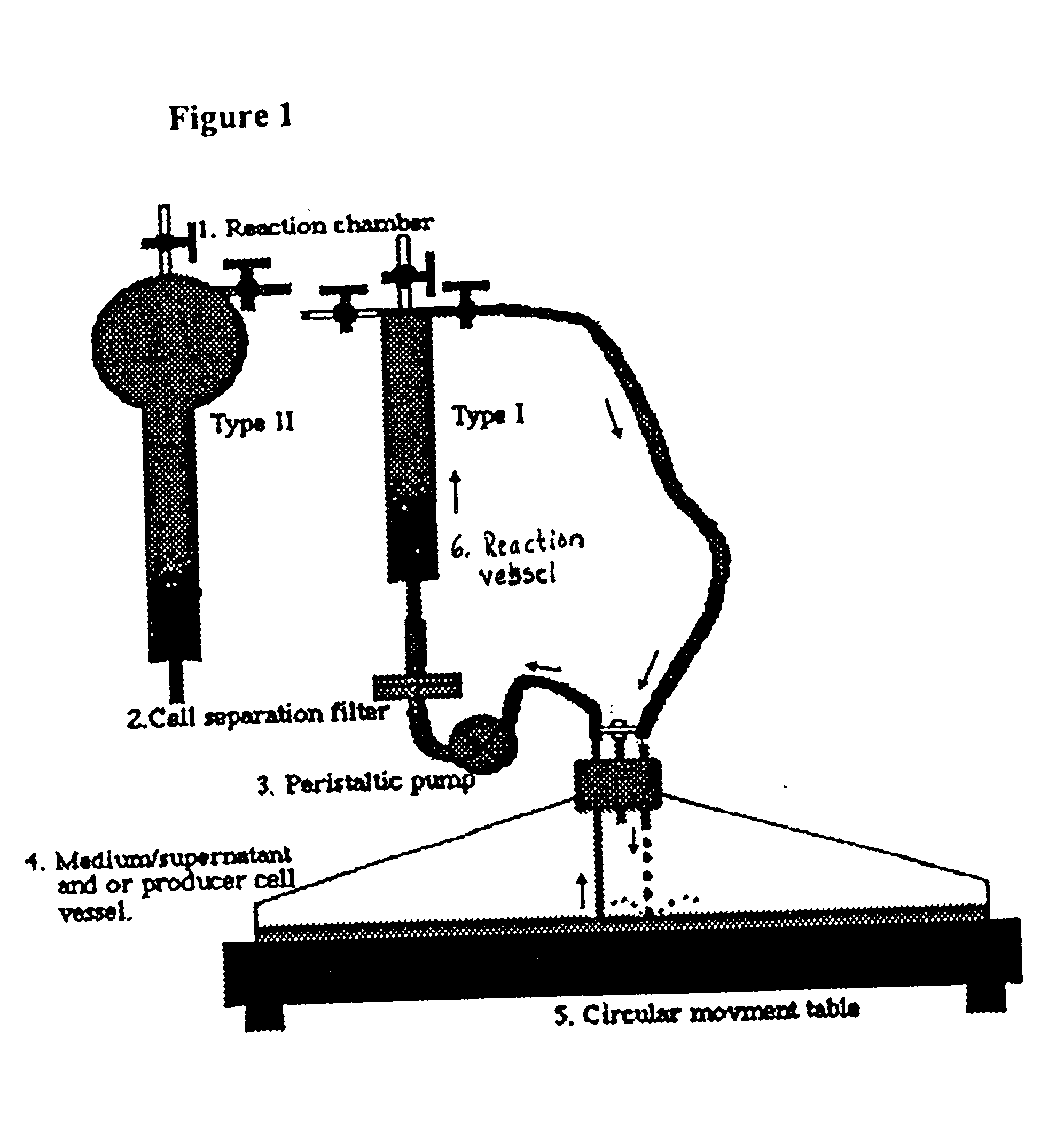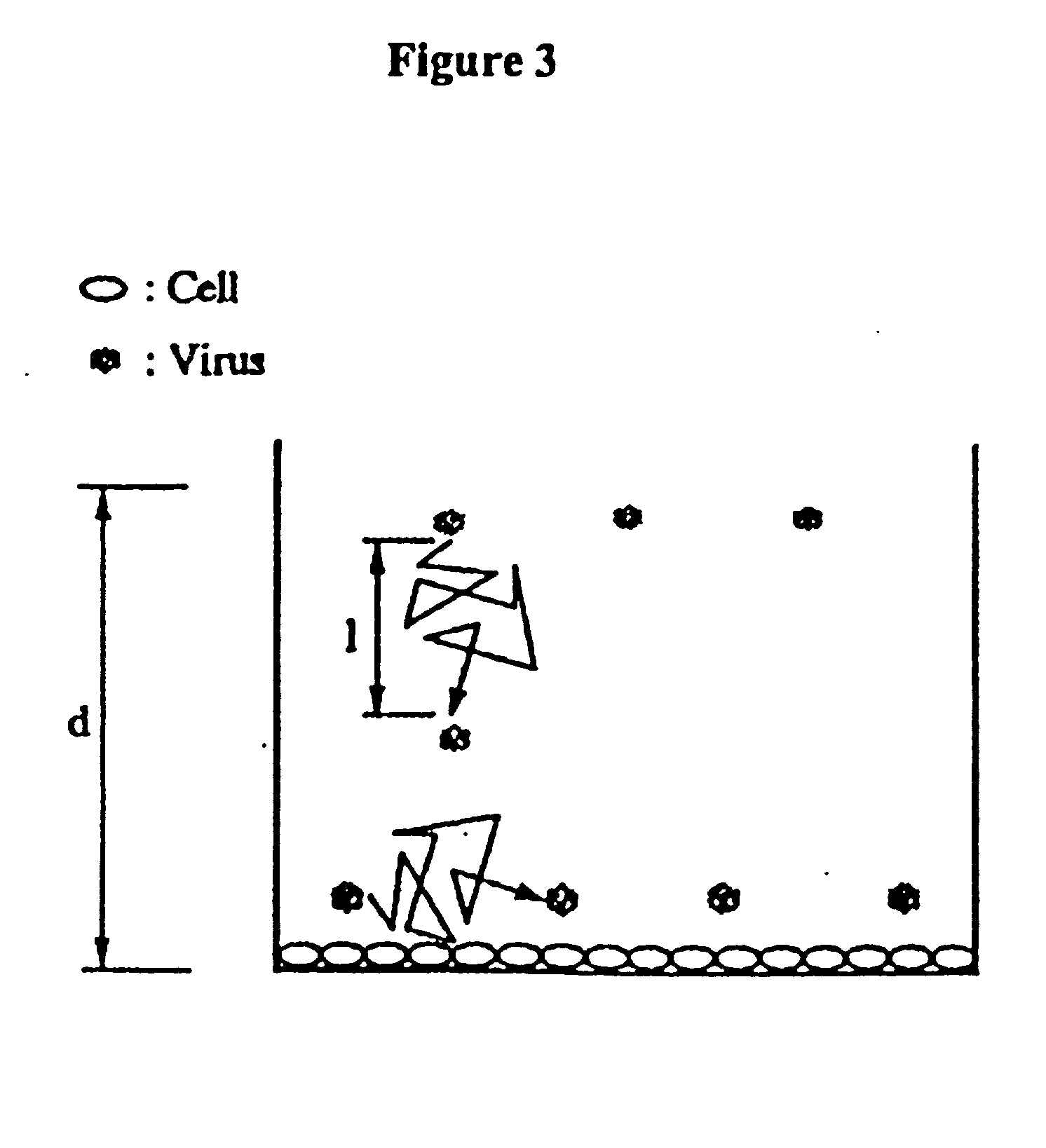Method of introducing organic molecules into target cells
- Summary
- Abstract
- Description
- Claims
- Application Information
AI Technical Summary
Problems solved by technology
Method used
Image
Examples
example 1
Retrovirus Mediated Gene Transfer with Retroviral Supernatant
[0087] The system is put together and autoclaved. The supernatant is aliquoted so that the final concentration is allowing a moi that you choose. In this example, a moi of 5 is used. For a normal human bone marrow transplantation it is usual to use about 100 million, or more, nucleated cells or at least 10 million CD34.sup.+ cells. In this case, 10 million CD34.sup.+ cells are used. To achieve a moi of 5 50 million cfu are needed. If the supernatant has a concentration of 700 000, 71 ml of the original supernatant will be needed. This is supplemented with appropriate media and cytokines. The media for murine BMC's is Dulbecco's Modified Eagle Medium (DMEM). The cytokines used are IL-3, IL-6 and mSCF. For human cells the same medium and cytokines are used, however, with the difference that the murine cytokines are replaced with the human counterparts.
[0088] To fill the system approximately 15 ml of media will be needed, so ...
example 2
Retrovirus Mediated Gene Transfer with Retrovirus Producer Cell Line
[0089] The system is put together and autoclaved. The medium for murine BMC's is Dulbecco's Modified Eagle Medium, DMEM. The cytokines used are IL-3, IL-6 and mSCF. The same medium is used for human CD34.sup.+ cells with the murine cytokines replaced with human counterparts. To fill the system, approximately 15 ml of medium is needed, so when making the media, this amount is put aside. First the media is supplemented with the cytokines. Then polybrene or another cation of choice is added. In this system a polybrene concentration of 4 pg / ml is used. The retrovirus producer cells is irradiated with 400 R and 500 000 cells is resuspended in the medium. The medium / supernatant container is filled up with 200 ml of cell suspension and put in to the incubator together with the rest of the apparatus. The cells are allowed to attach for 5 hours before proceding to fill the system. To fill the system the peristaltic pump is t...
example 3
Reverse Flow-through Transduction (RFTT) Apparatus Used for Non-viral Cell Targeting
[0090] In this example, CD34.sup.+ cells are transfected with a pEGFP.TM. vector using Superfect.TM..
[0091] The system is put together and autoclaved. For the purpose of transfecting cells no filter should be used, since that would disrupt the DNA / superfect aggregates. The media for murine BMC's is Dulbecco's Modified Eagle Medium, DMEM. The cytokines used are IL-3, IL-6 and mSCF. The same media is used for human CD34.sup.+ cells with the murine cytokines replaced with human counterparts. If cells are used that demands a different medium this has to be used instead of DMEM. To fill the system approximately 15 ml of media is needed, so when making the media, this amount is put a side. The medium / supernatant container is filled up with 200 ml of medium and put in to the incubator together with the rest of the apparatus. To fill the system the peristaltic pump is turned on and medium is pumped until it ...
PUM
| Property | Measurement | Unit |
|---|---|---|
| Time | aaaaa | aaaaa |
| Force | aaaaa | aaaaa |
| Centrifugal force | aaaaa | aaaaa |
Abstract
Description
Claims
Application Information
 Login to view more
Login to view more - R&D Engineer
- R&D Manager
- IP Professional
- Industry Leading Data Capabilities
- Powerful AI technology
- Patent DNA Extraction
Browse by: Latest US Patents, China's latest patents, Technical Efficacy Thesaurus, Application Domain, Technology Topic.
© 2024 PatSnap. All rights reserved.Legal|Privacy policy|Modern Slavery Act Transparency Statement|Sitemap



